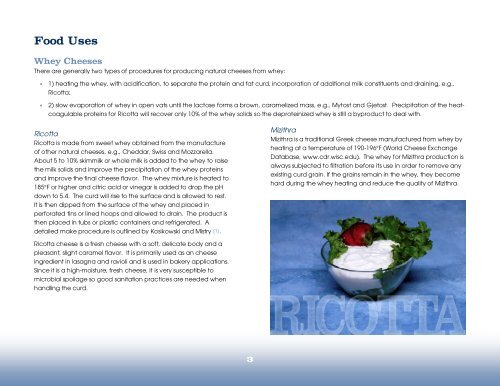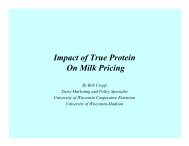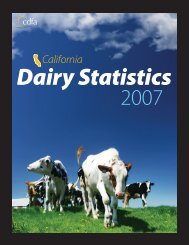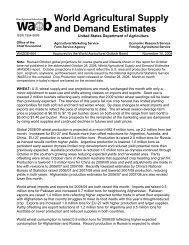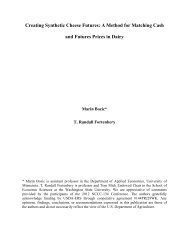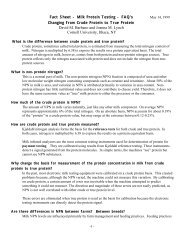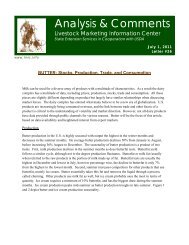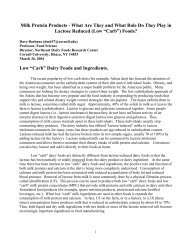Uses of Whey in the Farmstead Setting - Understanding Dairy Markets
Uses of Whey in the Farmstead Setting - Understanding Dairy Markets
Uses of Whey in the Farmstead Setting - Understanding Dairy Markets
Create successful ePaper yourself
Turn your PDF publications into a flip-book with our unique Google optimized e-Paper software.
Food <strong>Uses</strong><br />
<strong>Whey</strong> Cheeses<br />
There are generally two types <strong>of</strong> procedures for produc<strong>in</strong>g natural cheeses from whey:<br />
• 1) heat<strong>in</strong>g <strong>the</strong> whey, with acidification, to separate <strong>the</strong> prote<strong>in</strong> and fat curd, <strong>in</strong>corporation <strong>of</strong> additional milk constituents and dra<strong>in</strong><strong>in</strong>g, e.g.,<br />
Ricotta;<br />
• 2) slow evaporation <strong>of</strong> whey <strong>in</strong> open vats until <strong>the</strong> lactose forms a brown, caramelized mass, e.g., Mytost and Gjetost. Precipitation <strong>of</strong> <strong>the</strong> heatcoagulable<br />
prote<strong>in</strong>s for Ricotta will recover only 10% <strong>of</strong> <strong>the</strong> whey solids so <strong>the</strong> deprote<strong>in</strong>ized whey is still a byproduct to deal with.<br />
Ricotta<br />
Ricotta is made from sweet whey obta<strong>in</strong>ed from <strong>the</strong> manufacture<br />
<strong>of</strong> o<strong>the</strong>r natural cheeses, e.g., Cheddar, Swiss and Mozzarella.<br />
About 5 to 10% skimmilk or whole milk is added to <strong>the</strong> whey to raise<br />
<strong>the</strong> milk solids and improve <strong>the</strong> precipitation <strong>of</strong> <strong>the</strong> whey prote<strong>in</strong>s<br />
and improve <strong>the</strong> f<strong>in</strong>al cheese flavor. The whey mixture is heated to<br />
185°F or higher and citric acid or v<strong>in</strong>egar is added to drop <strong>the</strong> pH<br />
down to 5.4. The curd will rise to <strong>the</strong> surface and is allowed to rest.<br />
It is <strong>the</strong>n dipped from <strong>the</strong> surface <strong>of</strong> <strong>the</strong> whey and placed <strong>in</strong><br />
perforated t<strong>in</strong>s or l<strong>in</strong>ed hoops and allowed to dra<strong>in</strong>. The product is<br />
<strong>the</strong>n placed <strong>in</strong> tubs or plastic conta<strong>in</strong>ers and refrigerated. A<br />
detailed make procedure is outl<strong>in</strong>ed by Kosikowski and Mistry ( 1 ) .<br />
Ricotta cheese is a fresh cheese with a s<strong>of</strong>t, delicate body and a<br />
pleasant, slight caramel flavor. It is primarily used as an cheese<br />
<strong>in</strong>gredient <strong>in</strong> lasagna and ravioli and is used <strong>in</strong> bakery applications.<br />
S<strong>in</strong>ce it is a high-moisture, fresh cheese, it is very susceptible to<br />
microbial spoilage so good sanitation practices are needed when<br />
handl<strong>in</strong>g <strong>the</strong> curd.<br />
3<br />
Mizithra<br />
Mizithra is a traditional Greek cheese manufactured from whey by<br />
heat<strong>in</strong>g at a temperature <strong>of</strong> 190-196°F (World Cheese Exchange<br />
Database, www.cdr.wisc.edu). The whey for Mizithra production is<br />
always subjected to filtration before its use <strong>in</strong> order to remove any<br />
exist<strong>in</strong>g curd gra<strong>in</strong>. If <strong>the</strong> gra<strong>in</strong>s rema<strong>in</strong> <strong>in</strong> <strong>the</strong> whey, <strong>the</strong>y become<br />
hard dur<strong>in</strong>g <strong>the</strong> whey heat<strong>in</strong>g and reduce <strong>the</strong> quality <strong>of</strong> Mizithra.


